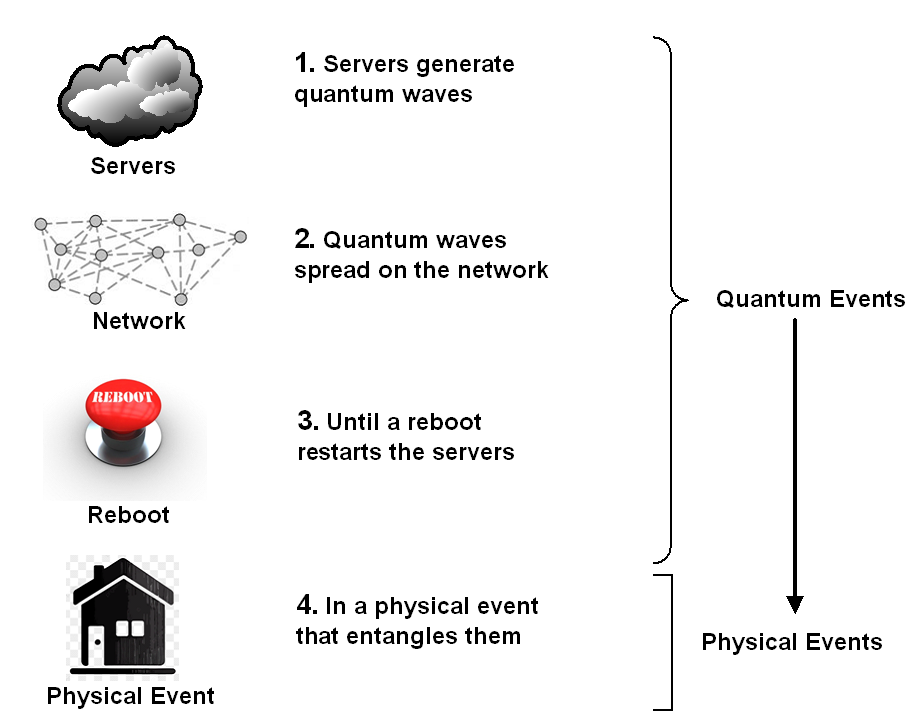Last century, physics invented a tale of quantum waves that spread at light speed then collapse instantly into physical events that begin the waves again. It made no sense, because physical waves can’t restart like that, but these strange waves predicted atomic events amazingly. The result was modern technologies like (Jenner, 2014):
- Transistors that run devices like smartphones work thanks to quantum laws.
- Medical devices like MRI (Magnetic Resonance Imaging) look within the body without surgery thanks to quantum laws.
- Global Positioning Systems (GPS) let us navigate the world thanks to quantum laws.
- Lasers scan barcodes at supermarkets thanks to quantum laws.
- Solar panels convert sunlight into electricity thanks to quantum laws.
- LEDs (light-emitting diodes) run the sensor lights on TVs thanks to quantum laws.
Without quantum laws, these technologies wouldn’t exist, but last century physics made the theory behind them imaginary because it was physically impossible. But if the technologies are real, how can their theory be imaginary? One possibility, not recognized initially, is that quantum theory describes processing waves spreading on a network, because such waves can:
- Evolve stepwise. Quantum waves evolve one step at a time. Physical waves don’t do this, but waves on a network pass from one point to the next in a stepwise fashion. Quantum waves could then evolve step-by-step because each step is a network cycle.
- Superpose to a limit. Quantum waves superpose probabilities up to a limit of one. Physical waves don’t do this, as they can be any height, but waves on a network can’t exceed the capacity of a network point. Quantum waves could then have a size limit because each network point has a bandwidth, beyond which it overloads and reboots.
- Collapse instantly. Quantum waves collapse instantly to restart at a point. Physical waves can’t do this, but a wave run by a server can restart at a point. A quantum wave could then collapse instantly because a network point reboots to restart its server.
- Entangle at a restart point. When quantum waves restart at the same point in a physical event, they entangle to become one. Physical waves don’t do this, as they just pass through each other, but two processes restarting at the same point could merge into one. Quantum waves could then entangle at a point because their servers merge their processing.
Later chapters give more details, but essentially quantum weirdness isn’t weird in computer terms. Processing waves on a network can evolve stepwise, superpose to a limit, collapse instantly, and entangle by the nature of processing. The resulting model of how quantum events cause physical events has these aspects (Figure 2.15):
- Servers. Servers generate and restart quantum waves.
- Network. Quantum waves spread and superpose on the network.
- Reboot. Until a point overloads and reboots, to request server restarts.
- Physical Event. A physical event restarts the waves at the same point, which entangles them.

A photon is a processing wave that spreads on a network until it overloads a point, in a physical event that restarts it again, so quantum waves are never lost. If quantum waves evolve stepwise when passed on, superpose when they overlap, collide when they overload a point, collapse when they restart, and entangle when their servers merge, then quantum theory is literally true.
The only strange thing about this model now is that the last step is an observed physical event. According to quantum theory, we observe a photon by interacting with its quantum wave in a physical event. This is an action, so we create our observation of the photon. The quantum waves around us only become physical events when “touched”, like a painting that appears only when painted, one brushstroke at a time, and we aren’t the only painters, as atoms also paint events. The surface painted on, which we call space, can curve, and the clock counting the strokes, which we call time, can slow down, as Einstein deduced. Relativity gives each painter their own canvas and clock, so space and time are generated locally, along with each physical event.
If time and space began when our universe did, before that they didn’t exist. Hawking concluded the same, arguing that nothing existed before our universe (Hertog, 2024), but how can nothing create a universe? The alternative is that what began our universe also began its space and time. Physical realism doesn’t say how time and space began, let alone matter, but quantum realism lets space and time begin with the first physical event.
To think the first event was just about light or matter is to underestimate it, as it needed space and time as well. We can picture making objects but making time and space is hard to imagine Scientists expected the first event to be about matter, and theologists expected their divinity to create a perfect world, but the evidence is that our universe didn’t begin with humans, animals, sky, or earth as they are now, but with what led to them. Our universe then began as a primal seed that after fifteen billion years has grown into galaxies, stars, planets, life, and us. The first event made not only things but also space and time, and not only then but also now, so the rabbit-hole of quantum reality runs deeper than even its advocates suppose.
Table 2.1 compares quantum realism with physical realism for space and time, so the reader can decide which explains the evidence better. The following chapters use the above model to explain the behavior of light (Chapter 3), matter (Chapter 4), and relativity (Chapter 5). They also make a testable prediction that current theory denies – that pure light can collide (4.5.9). Chapter 5 ends Part I, on the observed world, and Part II applies the same model to the observer.